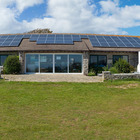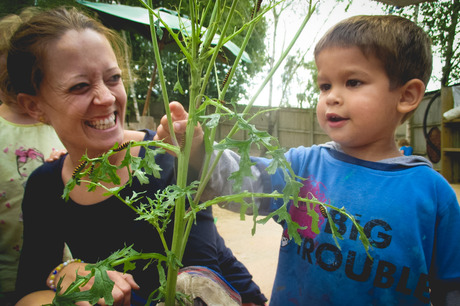
In December 2015, the Paris conference saw the first universal, legally binding global agreement on climate change. Today’s three-year-olds will be the adults driving this forward in the future, and their educational experiences ought to equip them with relevant skills and understanding. This doesn’t mean formal lessons in environmental issues; it is about experiences that will inspire children and enable them to grow up seeing sustainability as the norm.
 Our three nurseries are all within country parks. Our setting at Durlston Country Park in Swanage is on a coastal nature reserve and UNESCO World Heritage site. The nursery is in the former visitor centre, which has solar panels providing both heating and hot water. At Avon Heath, near Bournemouth, a log burner provides the heating, with the wood coming from trees felled as part of the management of the heath. The setting is nestled in 600 acres of protected land, with many of the animals only found within this habitat. The rangers here work with children and teachers for two-hour ‘explorer’ sessions in the morning and afternoon. Sustainability involves considering economic, social and cultural issues: these systems mean our heating costs are negligible and that we are working in harmony with the needs of the country park. The children grow and eat their own produce on all our sites.
Our three nurseries are all within country parks. Our setting at Durlston Country Park in Swanage is on a coastal nature reserve and UNESCO World Heritage site. The nursery is in the former visitor centre, which has solar panels providing both heating and hot water. At Avon Heath, near Bournemouth, a log burner provides the heating, with the wood coming from trees felled as part of the management of the heath. The setting is nestled in 600 acres of protected land, with many of the animals only found within this habitat. The rangers here work with children and teachers for two-hour ‘explorer’ sessions in the morning and afternoon. Sustainability involves considering economic, social and cultural issues: these systems mean our heating costs are negligible and that we are working in harmony with the needs of the country park. The children grow and eat their own produce on all our sites.
PARTNER UP
If you are keen to develop a more sustainable approach, mentors and partners can be enormously helpful. When setting up our organic farm, which is on our third site, Lymington in Hampshire, and has pygmy goats and chickens, a local farmer helped with everything from planting seasonal vegetables to providing tractor tyres to reuse as planters. Research your local area and find out who is committed to sustainability so you can identify potential partners.
We have also benefited from partnerships with country parks that have worked with the children and provided tips on how to ensure we are supporting the natural habitat of the park, and wildlife trusts that have helped us to build willow tunnels.
Research can also help identify sources of funding. Our nursery at Lymington received a grant from the New Forest National Park Sustainable Development Fund to create a wildlife pond, a wood-fired clay oven (for tasty pizza), a composting system and a rainwater harvesting system, which collects rainwater in an underground tank to water the farm. Although the cost of this can run into the thousands, the grant enabled us to go ahead. These sustainable measures mean we are helping the environment, saving many hours of staff time watering the farm and, because we are on a water meter, we are also reducing our bills. Plus it means children learn about recycling, composting, the importance of caring for the natural world, and about economic sustainability.
a composting system and a rainwater harvesting system, which collects rainwater in an underground tank to water the farm. Although the cost of this can run into the thousands, the grant enabled us to go ahead. These sustainable measures mean we are helping the environment, saving many hours of staff time watering the farm and, because we are on a water meter, we are also reducing our bills. Plus it means children learn about recycling, composting, the importance of caring for the natural world, and about economic sustainability.
A final addition was our compostable toilet, which gives our younger children quick access to a loo while outdoors – particularly useful for making potty training more fun.
LONG-TERM GOAL
Committing to sustainability can seem like a big task, but key to achieving any change is getting your team on board. Start by dedicating a staff brainstorming session to the idea of sustainability. Their involvement in the development of the idea will give them a feeling of ownership. As with anything, inspiring people with your own passion and commitment is key. Arm yourself with key facts about the importance of tackling climate change, and be willing to listen to and resolve their concerns. Then, add ‘sustainability’ to your nursery development plan, set achievable goals for the first year, and review these after six months.
Change takes time, so see this as a long-term project. Make it fun, and challenge both children and staff to see who can remember to turn light switches off, use just the right amount of water and re-use materials.
As well as learning about ‘green’ things, the children develop compassion, independence and problem-solving skills. For example, finding that we had a surplus of vegetables, the children suggested selling the produce and sending the proceeds to children in Africa, leading to a partnership with a charity in Nairobi.
Nelson Mandela said, ‘Education is the most powerful weapon which you can use to change the world.’ We may not be able to change the world overnight, but by embracing sustainability we hope to make a small difference, and inspire future generations to do the same.
Kids Love Nature was founded by Alex Shepherd and Ben Walliman, who combine forest kindergarten approaches with Reggio Emilia and Montessori. All its nurseries are rated Outstanding.

SARAH’S TOP PLACES TO START
- Source local/organic fruit and vegetables through a box scheme. Local shops or farmers may provide better value options than nationwide suppliers.
- Install a water butt. This will mean you can collect rainwater to use for watering plants.
- Operate a car-sharing scheme for parents or staff.
- Give each child their own reusable ‘wet bag’ instead of plastic bags.
- Involve the children when purchasing materials for the nursery.
- ‘Reduce, reuse, recycle’, and source materials for activities from a scrap store.
- Make contact with settings in other countries.









